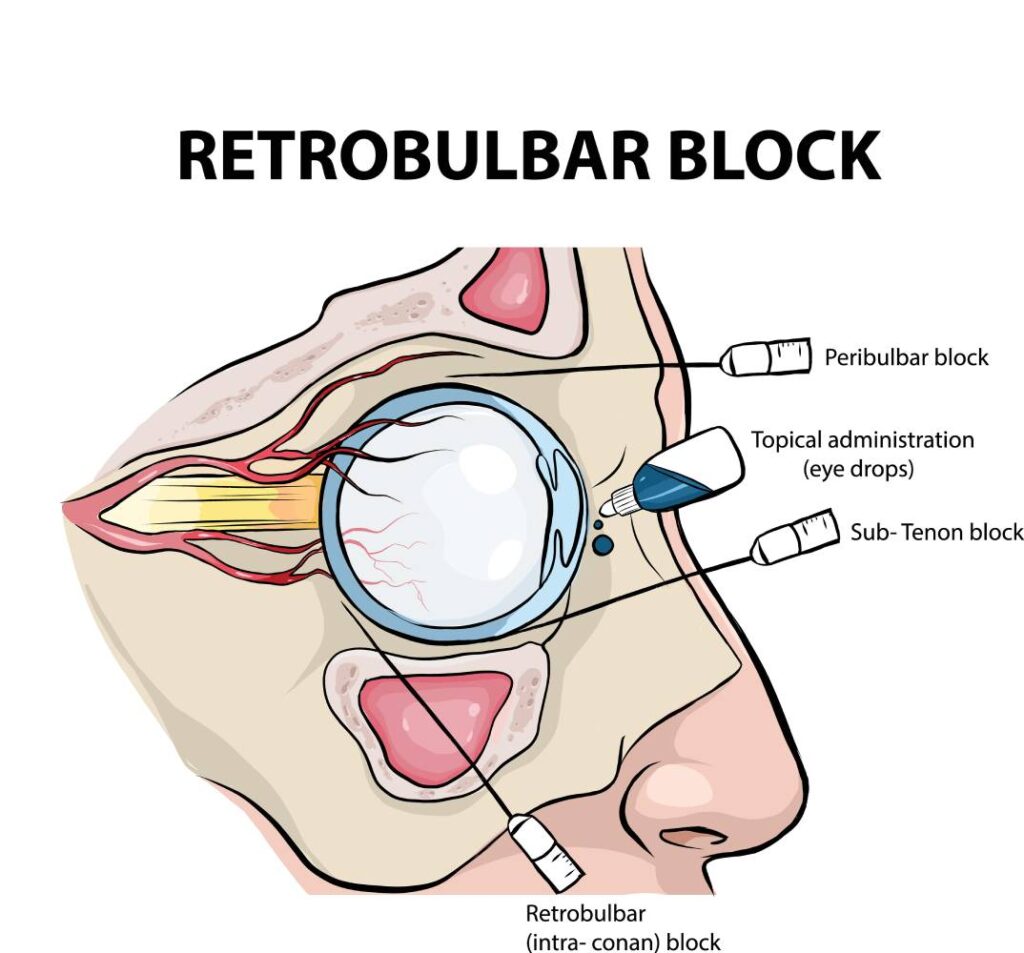Currently, there are approximately 4.2 million adults in the United States who are visually impaired. Early diagnosis and treatment, including surgery, have the potential to reverse vision impairment, such as cataract extraction, or slow and reduce the progression of diseases such as glaucoma and diabetic retinopathy (1). Anesthesia providers who specialize in ophthalmic procedures are critical to ensuring that patients have a comfortable and safe surgical experience. There are several options for anesthesia during eye surgery, including local, regional, or general anesthesia. Regional anesthesia, such as retrobulbar or peribulbar block, is commonly used for ophthalmic procedures to immobilize and numb the eye at the same time (1). However, challenges associated with the retrobulbar block has led to interest in and greater use of alternatives during eye surgery.
A retrobulbar block involves injecting a local anesthetic into the muscle cone of the eye. This procedure involves inserting a needle near the junction of the inferior and lateral walls of the orbit, just above the inferior orbital rim (2). The needle is carefully advanced parallel to the floor of the orbit until it passes the equator of the eye. The needle is then directed to a point behind the globe where the local anesthetic solution is injected. This block provides rapid relief and is associated with reduced chemosis (conjunctival swelling).
However, retrobulbar block may have complications such as retrobulbar hemorrhage, which occurs in approximately 1% of injections (3). Severe vision loss may occur and may require a lateral canthotomy, a surgical procedure to relieve pressure in the eye socket. In some cases, the local anesthetic may still be injected into the blood vessels even though the aspiration test shows no evidence of this. However, the minimal amount used in ophthalmic procedures greatly reduces the likelihood of systemic effects, even when the entire dose is administered intravenously. Accidental injection into an artery may result in central nervous system stimulation and seizures (1). Administering a local anesthetic or tracing along the optic nerve sheath may result in brainstem anesthesia, which can manifest as various symptoms ranging from confusion to cardiac arrest. Severe complications of retrobulbar block include optic nerve damage, globe perforation, retinal detachment, and vitreous hemorrhage. These complications can be devastating (2). Factors that increase the likelihood of these complications include physician inexperience and severe myopia. Success in performing this block requires high levels of skill and experience.
Alternatives to retrobulbar block include peribulbar block and sub-Tenon block, which both can provide regional anesthesia for eye surgery. Peribulbar block involves injecting a local anesthetic outside the muscle cone (1). This greatly reduces the risk of retrobulbar hemorrhage or optic nerve damage. The procedure typically requires one or two injections, depending on the surgeon’s preference. Peribulbar block has been shown to provide comparable patient analgesia and operating conditions to retrobulbar block. A sub-Tenon block uses a blunt cannula placed under the Tenon’s fascia. This method helps to avoid the potential complications that can occur with the use of sharp needles. The cannula is positioned posteriorly, without extending beyond the equator of the globe, and the local anesthetic is administered. This technique provides exceptional pain relief (1).
In general, regional anesthesia techniques used in intraocular surgery are considered reliable and risk-free, while providing adequate postoperative analgesia. They offer certain advantages over general anesthesia, including a reduced risk of postoperative nausea and vomiting and a faster recovery time for patients to return home. However, certain patients may find it difficult to undergo surgery with regional anesthesia alone, possibly due to factors such as anxiety or difficulty cooperating.
References
- Eriksson LI., Fleisher LA., Wiener-Kronish JP. Miller’s Anesthesia.; 2020. ISBN: 0323596045, 9780323596046.
- Alhassan MB, Kyari F, Ejere HO. Peribulbar versus retrobulbar anaesthesia for cataract surgery. Cochrane Database Syst Rev. 2015;2015(7):CD004083. Published 2015 Jul 2. doi:10.1002/14651858.CD004083.pub3.
- Polania Gutierrez JJ, Riveros Perez E. Retrobulbar Block. In: StatPearls. Treasure Island (FL): StatPearls Publishing; May 30, 2023.
